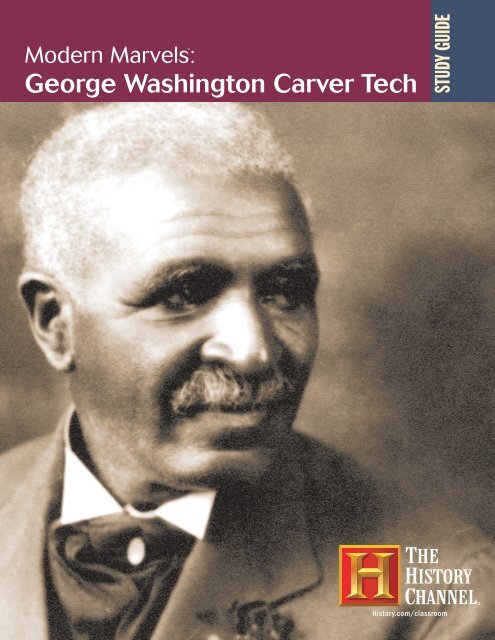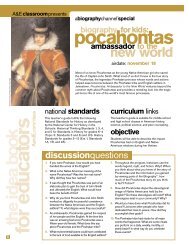George Washington Carver Tech
George Washington Carver Tech
George Washington Carver Tech
Create successful ePaper yourself
Turn your PDF publications into a flip-book with our unique Google optimized e-Paper software.
®<br />
Modern Marvels:<br />
<strong>George</strong> <strong>Washington</strong> <strong>Carver</strong> <strong>Tech</strong><br />
STUDY GUIDE<br />
History.com/classroom
STUDY GUIDE<br />
®<br />
MODERN MARVELS:<br />
<strong>George</strong> <strong>Washington</strong> <strong>Carver</strong> <strong>Tech</strong><br />
Named after the nation’s first president, one of the most important<br />
inventors of the 20th century was born into slavery. <strong>George</strong><br />
<strong>Washington</strong> <strong>Carver</strong> was born in rural Missouri in 1864 and despite<br />
the challenges of slavery, poverty, and becoming an orphan, he<br />
dedicated his life to using science and technology to advance<br />
the lives of everyday people. <strong>Carver</strong>’s research and innovations<br />
influenced and shaped a wide range of national industries, ranging<br />
from agriculture to automotive to aerospace. This inspiring episode<br />
in the Modern Marvels series traces <strong>Carver</strong>’s life through his many<br />
experiments, inventions and novel ideas to reveal how this humble<br />
and quiet man became a primary contributor to the technological<br />
and economic life of the nation. An hour-long program, this episode<br />
traces <strong>Carver</strong>’s inventions and their common uses in our society<br />
today. Perhaps best known for his work with the peanut, <strong>Carver</strong><br />
amazingly found over 300 uses for this crop. Driven by a desire to<br />
lift his fellow African Americans out of poverty, <strong>Carver</strong> used his<br />
research skills to encourage the development of new crops in the<br />
South as the unstable cotton market put many black Southerners<br />
in economic peril. Through his work as a teacher at Iowa State<br />
University and Tuskegee University, <strong>Carver</strong> found that peanuts<br />
and soybeans had medicinal value, could be used as an alternative<br />
energy source, and that their oils could be used as a base for automobile parts and other valuable materials.<br />
<strong>George</strong> <strong>Washington</strong> <strong>Carver</strong> <strong>Tech</strong> highlights the longevity of these findings as <strong>Carver</strong>’s inventions continue to have<br />
countless contemporary applications in a wide variety of industries. This engaging exploration of <strong>Carver</strong>’s life<br />
and work will introduce students to an amazing man whose simple and unassuming nature belied the enormity<br />
of his influence. With insights provided by former NBA star David Robinson and others, this program will<br />
motivate students to learn more about <strong>Carver</strong> and other influential African Americans during Black History<br />
Month and throughout the year.<br />
CURRICULUM LINKS:<br />
Modern Marvels: <strong>George</strong> <strong>Washington</strong> <strong>Carver</strong> <strong>Tech</strong> would be useful for History, Social Studies, American Culture,<br />
and Science and <strong>Tech</strong>nology Courses. It fulfills the following guidelines outlined by the National Center for<br />
History Education: Cultural Innovation and Diffusion and Human Interaction with the Environment. It is<br />
an excellent resource for courses, events, and programs related to Black History Month. It is appropriate for<br />
middle school and high school.<br />
MODERN MARVELS: GEORGE WASHINGTON CARVER TECH<br />
1
STUDY GUIDE<br />
VOCABULARY:<br />
agronomist<br />
access<br />
dubious<br />
conspicuous<br />
advocacy<br />
extraction<br />
distillation<br />
dilemma<br />
cash crop<br />
DISCUSSION QUESTIONS:<br />
1. How did <strong>George</strong> <strong>Washington</strong> <strong>Carver</strong> manage to become so well-educated despite behind born into<br />
poverty and slavery<br />
2. How do you think <strong>Carver</strong>’s early curiosity about art and nature shaped his focus on agriculture later in life<br />
3. Why did <strong>Carver</strong> originally start to experiment with soybeans and soybean oil What uses for soybeans<br />
did he discover through his research<br />
4. Which of <strong>Carver</strong>’s inventions do you think was most influential<br />
5. What were some of the uses of peanut oil Why do you think <strong>Carver</strong> was so determined to find new uses<br />
for peanut oil and other experimental products<br />
6. <strong>Carver</strong> was always concerned that his inventions had a practical application. How does this differ from<br />
methods other scientists might use Why do you think <strong>Carver</strong> emphasized usefulness<br />
7. Why do you think <strong>Carver</strong> turned down the opportunity to make more money and achieve more fame<br />
based on his inventions<br />
8. What do you think were <strong>George</strong> <strong>Washington</strong> <strong>Carver</strong>’s top three priorities<br />
9. Who are some other inventors you admire other than <strong>Carver</strong> What qualities do you think most inventors<br />
have in common<br />
10. What do you think is the most lasting legacy of <strong>Carver</strong>’s life<br />
EXTENDED ACTIVITIES:<br />
1. The National Park Service created a monument and park dedicated to honoring <strong>George</strong> <strong>Washington</strong><br />
<strong>Carver</strong> in 1943. In addition to a statue of <strong>Carver</strong>, there are nature trails and special activities connected<br />
to <strong>Carver</strong>’s interests and innovations. Imagine that you have been asked to design a monument to<br />
<strong>Carver</strong>. Think about how you would represent him and use your creativity to construct a monument that<br />
captures <strong>Carver</strong>’s life, work and contributions. Write an essay describing your monument, or make a<br />
visual representation of the monument by creating a drawing, painting, or making a 3-D clay model.<br />
Share your design with your class or group.<br />
2. Among the many ways <strong>George</strong> <strong>Washington</strong> <strong>Carver</strong> aimed to assist poor Southern farmers was by traveling<br />
through the Southern states with his “movable school.” With the “movable school,” <strong>Carver</strong> assembled<br />
tools, displays, and a traveling group of experts who would teach new techniques to African-American<br />
farmers and provide them with the services they needed to thrive amidst great poverty. Imagine that you<br />
are able to build your own “movable school.” What issue or area would your school be related to and what<br />
would you include in it On a piece of construction paper or posterboard, illustrate your fictional “movable<br />
school” and include images or lists of the items, experts, and ideas crucial to your school. Share your ideas<br />
with your larger class or group.<br />
MODERN MARVELS: GEORGE WASHINGTON CARVER TECH<br />
2
3. As this program describes, one of the incredible things about <strong>George</strong> <strong>Washington</strong> <strong>Carver</strong>’s life is the<br />
wide variety of contributions he made to so many different industries. <strong>Carver</strong>’s inventions reshaped the<br />
agriculture and automotive industries, among many others. Choose one of <strong>Carver</strong>’s inventions discussed in<br />
the program or one that you discover on your own. At the library or using the Internet, do some additional<br />
research into this invention. Write a short essay of 2 to 3 pages describing this invention including the<br />
research <strong>Carver</strong> conducted and the reason he felt this innovation was important, and what he saw as the<br />
larger purpose it would serve. You can also include the modern-day uses of your chosen invention.<br />
4. <strong>George</strong> <strong>Washington</strong> <strong>Carver</strong> lived an incredible life full of inventions, educational achievements, and<br />
contributions to the African-American community. Pretend that you are a newspaper reporter who<br />
has been assigned the task of writing <strong>Carver</strong>’s obituary after he has died. In a short obituary of 500<br />
words or less, write about the life of <strong>Carver</strong>. You can supplement your knowledge of his life by exploring<br />
additional biographies of him at the library or using the Internet. One of the challenges of this task is<br />
to capture such a compelling and full life using few words!<br />
ADDITIONAL RESOURCES<br />
Books:<br />
<strong>Carver</strong>, <strong>George</strong> <strong>Washington</strong> and Gary Kremer. <strong>George</strong> <strong>Washington</strong> <strong>Carver</strong>: In His Own Words (University<br />
of Missouri Press, 1991).<br />
Driscoll, Laura. <strong>George</strong> <strong>Washington</strong> <strong>Carver</strong>: The Peanut Wizard (Penguin Young Readers, 2003).<br />
McMurray, Linda. <strong>George</strong> <strong>Washington</strong> <strong>Carver</strong>: Scientist and Symbol (Oxford University Press, 1982).<br />
Moore, Eva and Alexander Anderson (Illustrator). The Story of <strong>George</strong> <strong>Washington</strong> <strong>Carver</strong>. (Scholastic, 1985).<br />
Websites:<br />
A helpful site from the National Park Service, with a brief autobiography written by <strong>Carver</strong>:<br />
http://www.nps.gov/gwca/expanded/auto_bio.htm<br />
The Iowa State University special website on <strong>George</strong> <strong>Washington</strong> <strong>Carver</strong>: http://www.lib.iastate.edu/<br />
spcl/gwc/home.html<br />
The United States Department of Agriculture page on <strong>Carver</strong>, with activities for younger students:<br />
http://www.usda.gov/oo/colorbook.htm<br />
A helpful general website: http://www.georgewashintoncarver.com/<br />
Did you know Other than peanuts, <strong>Carver</strong> also developed recipes for mayonnaise, instant coffee, and shaving<br />
cream, among many other items.<br />
Did you know The U.S. Navy has a ship in <strong>Carver</strong>’s name to honor his contribution. The motto of the USS<br />
<strong>George</strong> <strong>Washington</strong> <strong>Carver</strong> SSBN-656 is “Strength Through Knowledge.”<br />
©2006 AETN. 0063<br />
MODERN MARVELS: GEORGE WASHINGTON CARVER TECH<br />
3








